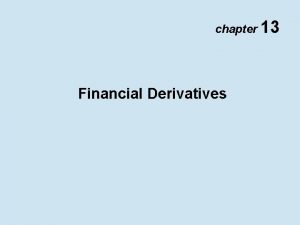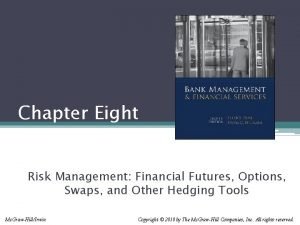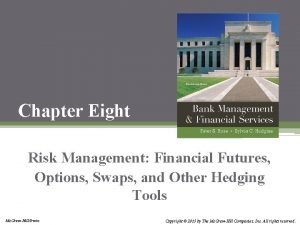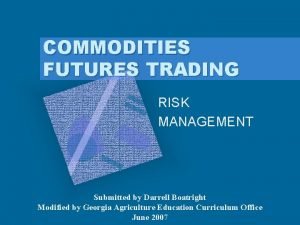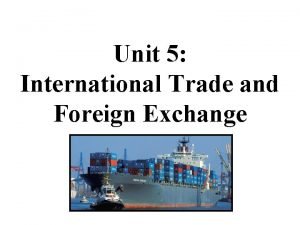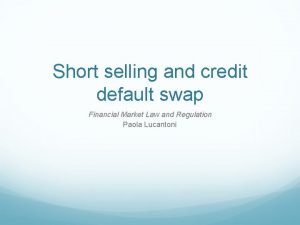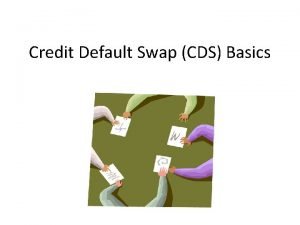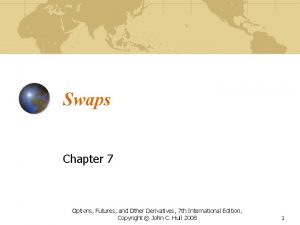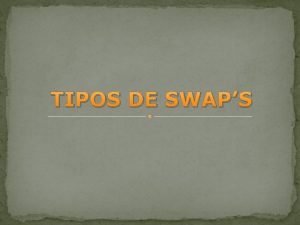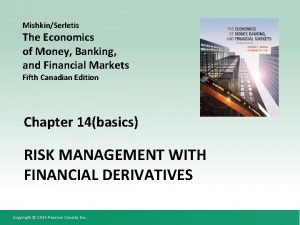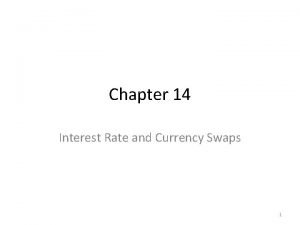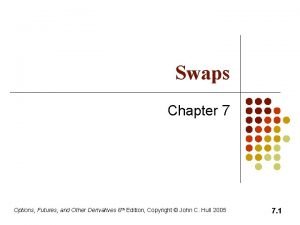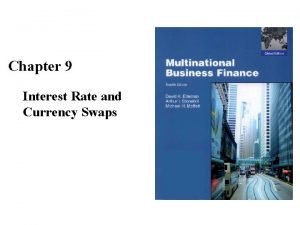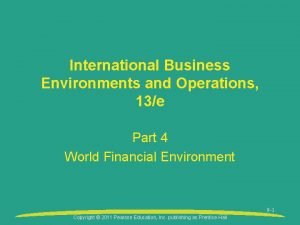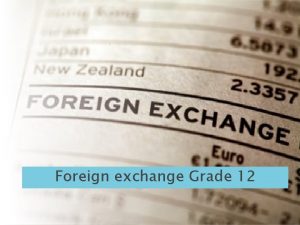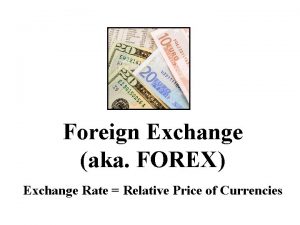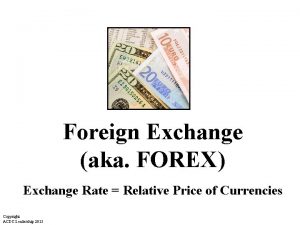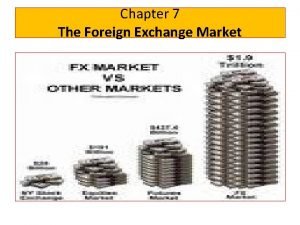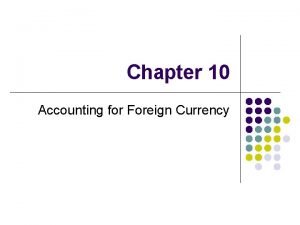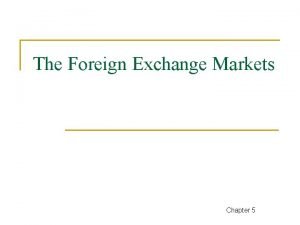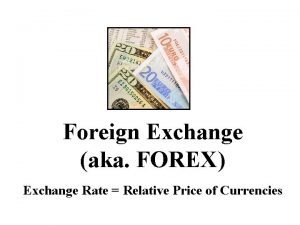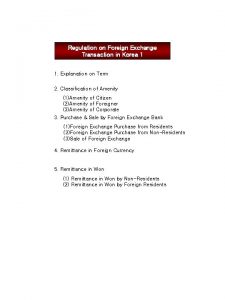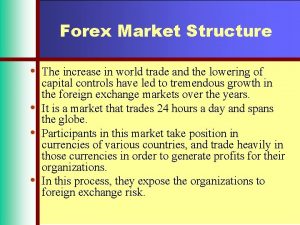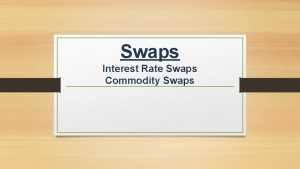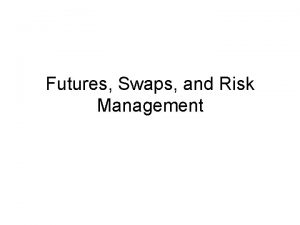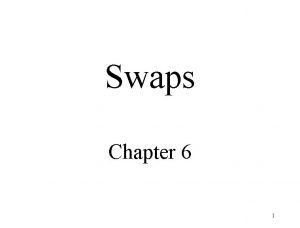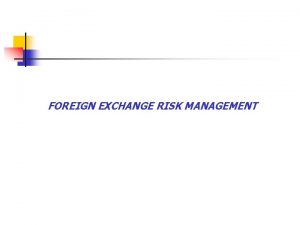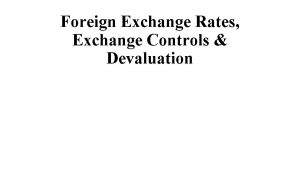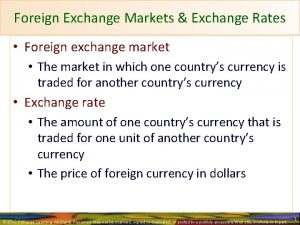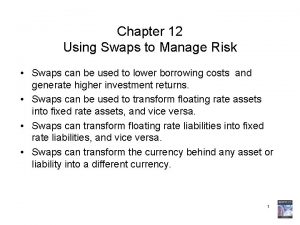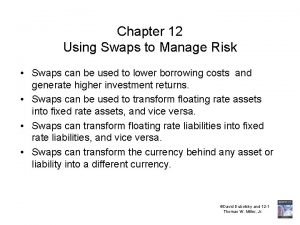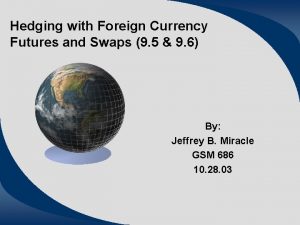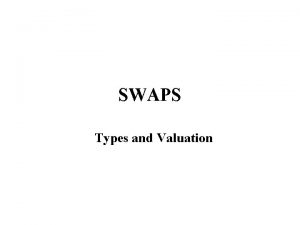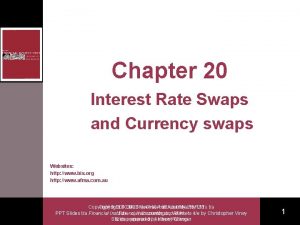Futures Swaps and Risk Management Foreign Exchange Futures



































- Slides: 35

Futures, Swaps, and Risk Management

Foreign Exchange Futures • Exchanges rates between currencies vary – Exporters • The forward market in foreign exchanges – Informal – Banks and brokers • Futures markets – Chicago Mercantile (International Monetary Market) – London International Financial Futures Exchange – Mid. America Commodity Exchange • Active forward market


Figure 23. 2 Foreign Exchange Futures

Pricing on Foreign Exchange Futures SPOT-FUTURE EXCHANEG RATE RELATION Interest rate parity theorem Developed using the US Dollar and British Pound where F 0 is the forward price E 0 is the current exchange rate

Text Pricing Example rus = 5% T = 1 yr ruk = 6% E 0 = $1. 60 per pound If the futures price varies from $1. 58 per pound arbitrage opportunities will be present.



Direct versus Indirect Quotes • A dolar per pound – Direct exchange rate quote • A unit of foreign currency per dollar – Indirect exchange rate quote

Hedging Foreign Exchange Risk A US firm wants to protect against a decline in profit that would result from a decline in the pound • Estimated profit loss of $200, 000 if the pound declines by $. 10 • Short or sell pounds for future delivery to avoid the exposure

Hedge Ratio for Foreign Exchange Example Hedge Ratio in pounds $200, 000 per $. 10 change in the pound/dollar exchange rate $. 10 profit per pound delivered per $. 10 in exchange rate = 2, 000 pounds to be delivered Hedge Ratio in contacts Each contract is for 62, 500 pounds or $6, 250 per a $. 10 change $200, 000 / $6, 250 = 32 contracts

Figure 23. 3 Profits as a Function of the Exchange Rate

Stock Index Contracts • Available on both domestic and international stocks • Advantages over direct stock purchase – lower transaction costs – better for timing or allocation strategies – takes less time to acquire the portfolio

Table 23. 1 Major Stock-Index Futures

Table 23. 2 Correlations among Major U. S. Stock Market Indexes

Creating Synthetic Positions with Futures • Synthetic stock purchase – Purchase of the stock index instead of actual shares of stock • Creation of a synthetic T-bill plus index futures that duplicates the payoff of the stock index contract

Synthetic Position Using Stock. Index Futures

Index Arbitrage Exploiting mispricing between underlying stocks and the futures index contract • Futures Price too high - short the future and buy the underlying stocks • Futures price too low - long the future and short sell the underlying stocks

Index Arbitrage and Program Trading This is difficult to implement in practice • Transactions costs are often too large • Trades cannot be done simultaneously Development of Program Trading • Used by arbitrageurs to perform index arbitrage • Permits acquisition of securities quickly

Hedging Systematic Risk To protect against a decline in level stock prices, short the appropriate number of futures index contracts • Less costly and quicker to use the index contracts • Use the beta for the portfolio to determine the hedge ratio

Hedging Systematic Risk: Text Example Portfolio Beta =. 8 S&P 500 = 1, 000 Decrease S&P falls to 975 = 2. 5% Portfolio Value = $30 million Project loss if market declines by 2. 5% = (. 8) (2. 5) = 2% 2% of $30 million = $600, 000 Each S&P 500 index contract will change $6, 250 for a 2. 5% change in the index

Hedge Ratio: Text Example H= = Change in the portfolio value Profit on one futures contract $600, 000 $6, 250 = 96 contracts short

Figure 23. 4 Predicted Value of the Portfolio as a Function of the Market Index

Uses of Interest Rate Hedges • Owners of fixed-income portfolios protecting against a rise in rates • Corporations planning to issue debt securities protecting against a rise in rates • Investor hedging against a decline in rates for a planned future investment • Exposure for a fixed-income portfolio is proportional to modified duration

Hedging Interest Rate Risk: Text Example Portfolio value Modified duration = $10 million = 9 years If rates rise by 10 basis points (. 1%) Change in value = ( 9 ) (. 1%) =. 9% or $90, 000 Present value of a basis point (PVBP) = $90, 000 / 10 = $9, 000

Hedge Ratio: Text Example H= = PVBP for the portfolio PVBP for the hedge vehicle $9, 000 $90 = 100 contracts

Figure 23. 5 Yield Spread between 10 -Year Treasury and Baa-Rated Corporate Bonds

Swaps • Interest rate swap • Foreign exchange swap • Credit risk on swaps

Figure 23. 6 Interest Rate Swap

Figure 23. 7 Interest Rate Futures

Pricing on Swap Contracts Swaps are essentially a series of forward contracts. One difference is that the swap is usually structured with the same payment each period while the forward rate would be different each period. Using a foreign exchange swap as an example, the swap pricing would be described by the following formula.

Figure 23. 8 Forward Contracts versus Swaps

Commodity Futures Pricing General principles that apply to stock apply to commodities. Carrying costs are more for commodities. Spoilage is a concern. Where; F 0 = futures price P 0 = cash price of the asset C = Carrying cost c = C/P 0

Figure 23. 9 Typical Agricultural Price Pattern over the Season

Table 23. 3 Commodity Betas
 Advantages and disadvantages of derivatives
Advantages and disadvantages of derivatives Options futures and risk management
Options futures and risk management Traders in financial futures
Traders in financial futures Salient features of fema
Salient features of fema Futures trading risk management
Futures trading risk management Here you are too foreign for home
Here you are too foreign for home Market risk assessment
Market risk assessment International trade and foreign exchange
International trade and foreign exchange Foreign exchange and international financial markets
Foreign exchange and international financial markets Exchange member of jakarta
Exchange member of jakarta Many mncs use forward contracts.
Many mncs use forward contracts. Futures exchange
Futures exchange Taiwan fcm
Taiwan fcm Short position meaning
Short position meaning Selling credit default swaps
Selling credit default swaps Selling credit default swaps
Selling credit default swaps Swaps
Swaps Banker swaps rat race for bus lane
Banker swaps rat race for bus lane Mercados de forwards y swaps
Mercados de forwards y swaps Swapsmuy
Swapsmuy Advantages of interest rate swaps
Advantages of interest rate swaps Unwinding swaps
Unwinding swaps Swaps example
Swaps example Considering interestrate swaps, the swap rate is
Considering interestrate swaps, the swap rate is Forex trading process
Forex trading process Exchange rate grade 12
Exchange rate grade 12 Foreign exchange shifters
Foreign exchange shifters Foreign exchange shifters
Foreign exchange shifters Functions of foreign exchange market
Functions of foreign exchange market Foreign exchange accounting
Foreign exchange accounting Objectives of foreign exchange
Objectives of foreign exchange Xlri jamshedpur student exchange program
Xlri jamshedpur student exchange program 4 shifters of foreign exchange
4 shifters of foreign exchange Foreign exchange transaction regulation korea
Foreign exchange transaction regulation korea Hsbc forex rates
Hsbc forex rates Structure of the forex market
Structure of the forex market
